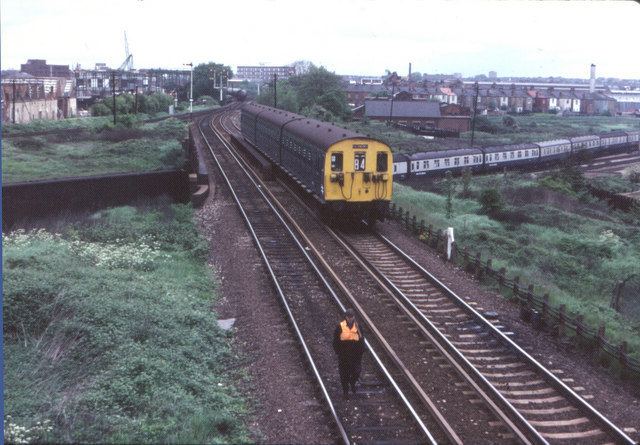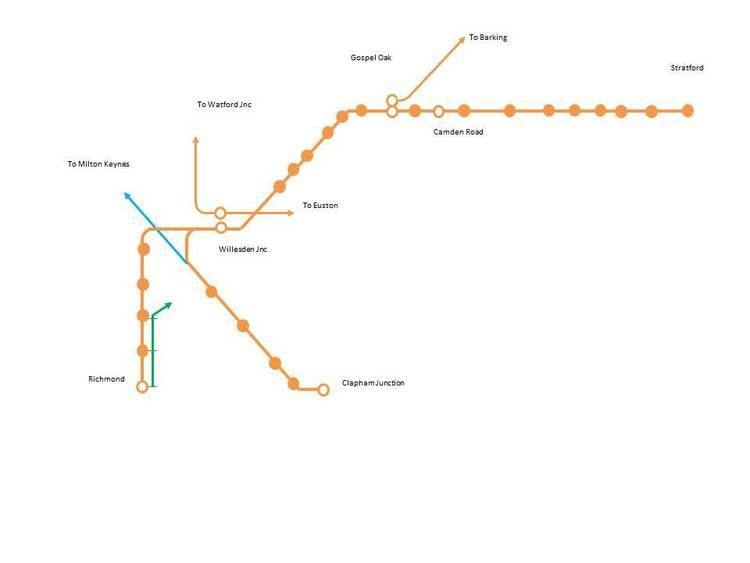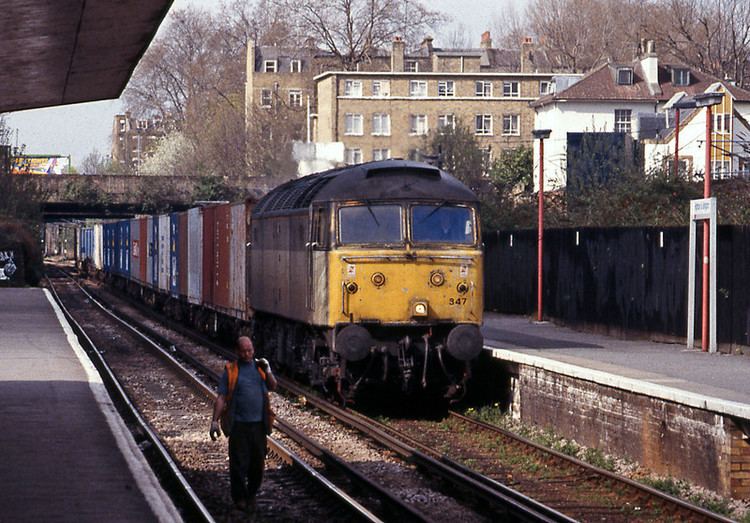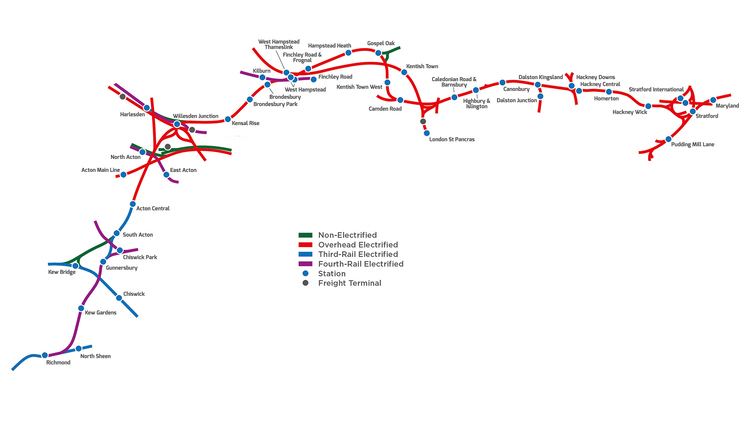Status Operational Stations 23 | Services 1 | |
 | ||
System National RailLondon Underground Closed Depot Willesden Traction Maintenance Depot Terminis Richmond (London) station, Stratford station, Stratford, London | ||
Train simulator 2016 route learning north london line stratford to richmond class 378
The North London line is a railway line of the London Overground, which passes through the inner suburbs of north London, England. Its route is a rough semicircle between the south-west and the north-east, avoiding central London. The line is owned and maintained by Network Rail and London Overground.
Contents
- Train simulator 2016 route learning north london line stratford to richmond class 378
- North london line in transition
- Formation
- Developments
- Closures
- Poor performance before the TfL take over
- TfL
- Former services
- Track
- Traction current supply
- Connections
- Interchanges shown on the tube map
- Other interchanges
- Former interchanges
- Rolling stock
- Service levels
- East London line extension
- 5 car operation
- Maiden Lane
- Crossrail to Hounslow
- Old Oak Common
- North Acton
- High Speed 2
- Closed stations
- City Extension
- North Woolwich section
- References

Although much of it originated as part of the North London Railway, the current route is the result of a series of amalgamations, closures and reopenings, and has a mix of third-rail and overhead electrical power supply. It is an important freight route and is used by the Richmond to Stratford service of the London Overground, as part of the National Rail network. Also, between Richmond and Gunnersbury, London Underground's District line shares tracks with London Overground services, although this part is also owned and maintained by Network Rail.

The line closed in February 2010 between Gospel Oak and Stratford for the installation of a new signalling system and the extension of 30 platforms, ultimately to allow four-car trains to run on the London Overground network. The line reopened on 1 June 2010 with a reduced service and none on Sundays, and with the upgrade work completed, the full seven-day service resumed on 22 May 2011.

North london line in transition
Formation

The North London line between Richmond and North Woolwich derives from five connecting sections which were opened over 25 years from 1846:

Developments

The line from Broad Street to Kew Bridge and Richmond was electrified by the LNWR in 1916 on the 4th-rail DC system.
In 1944, passenger services on the NLR Poplar branch ceased. Freight traffic continued on the branch to the docks on the Isle of Dogs until 1980. The trackbed of the southern part of the branch, from Poplar to Bow, was used for the Docklands Light Railway (DLR) branch to Stratford.
The service was listed for closure in the 1963 Beeching Report, with losses claimed as being £69,000 per year (£1.1 million in today's money). It was saved after a huge campaign. The line was Grant Aided under the Transport Act 1968 and came under threat when the Conservative Government of 1970-71 proposed to reduce Grant Aid funding. That threat, eventually lifted, led to the founding of a new campaign group, the North London Line Committee, which tried to work with British Rail management to promote the service.
In 1979, the North Woolwich to Stratford service was extended to Camden Road as the CrossTown LinkLine service, using the same Cravens-built diesel multiple unit trains. There were no intermediate stations until, in 1980, Hackney Wick was opened, near the site of the former Victoria Park station and Hackney Central was re-opened; then Homerton re-opened in 1985 (the two latter stations had closed in 1944). New platforms were built at West Ham for interchange with the adjacent Underground station.
Closures
In the 1980s, Broad Street station closed and the Tottenham Hale–Stratford link and the station at Lea Bridge ceased to be used by regular passenger trains. The line between Dalston and North Woolwich was electrified on the third-rail system and Broad Street services were diverted to North Woolwich using former Southern Region 2-EPB types built in the 1950s. The two-car trains soon proved too small and were replaced by three-car Class 313 electric multiple units. The new service was branded by British Rail as the North London Link, and some signs using this name still exist.
In December 2006, as with the Poplar branch (see above), the line between Stratford and North Woolwich was permanently closed to make a way for a future DLR extension from Canning Town to Stratford International (opened February 2011). The section south of Canning Town was not used by the DLR, as it is largely duplicated by the DLR King George V branch. Instead, the section will become part of Crossrail's branch to Abbey Wood (opening 2018). The section south of Stratford had always been the 'Cinderella' end of the line, in that when there were operating problems it was common for trains to be turned short at Stratford.
Poor performance before the TfL take over
Despite published performance figures, the North London line used to be regarded by frequent travellers as offering a poor service, with extremely congested trains and an unreliable service with trains often cancelled shortly before they are due to arrive. A 2006 London Assembly report described the current service as "shabby, unreliable, unsafe and overcrowded", proposing the transfer of the service to Transport for London (TfL) as a solution to improve the quality of the service due to upgrade plans which coincided with the extension of the East London line. A report on the line can be found on the London Assembly website.
TfL
The North London line, as part of Silverlink, along with the West London line, Gospel Oak to Barking Line and the Watford DC Line, was transferred to Transport for London (TfL) in 2007 to form its new London Overground service. TfL began to remodel stations, integrate lines and following the transfer and extension of the East London line, aims to create an orbital rail service. TfL also brought in new trains and the line, which previously appeared on tube maps following a public campaign, gained its own colour. TfL extensively refurbished and upgraded the line.
Former services
In addition to the primary Broad Street - Richmond service, there were services that linked Broad Street with Harrow & Wealdstone and Watford Junction on the West Coast Main Line. Most of these were routed via the line between South Hampstead and Camden Road, calling at Primrose Hill, although some travelled via Hampstead Heath and switched to the Watford line at Willesden Junction. By the time that Broad Street closed in 1986, the Watford services operated only in the rush hours, and they were diverted to Liverpool Street by way of a new link in Hackney, known as the Graham Road Curve. Trains were frequently cancelled as British Rail management needed to prioritise other services, and this led to falling patronage. British Rail applied to close the service in 1990 and the last trains ran two years later.
In 2000, Anglia Railways started a service between Basingstoke and Ipswich, utilising parts of the North London line. The service was called London Crosslink and ran up to five times a day at roughly two-hourly intervals. The service called only at principal stations such as Staines, Feltham and Brentford. On the North London line, the trains called only at Stratford, Highbury & Islington, Camden Road (some services), West Hampstead and Willesden Junction. The service was withdrawn in 2002.
The AC electrification of the eastern part of the North London line uses the previously unelectrified northern pair of tracks, which were also partially singled at the same time. Between Canonbury and Highbury & Islington, there is a line which links to the East Coast Main Line at Finsbury Park. This used to carry passenger trains to and from various main line stations (such as Edgware, Alexandra Palace, High Barnet, Welwyn Garden City and others) over part of the North London line to Broad Street Station; however, with the electrification of the Great Northern Electrics suburban lines in 1976, trains were diverted into Moorgate and London King's Cross stations, so since then this link has only been used for freight trains. It too was singled concurrent with the AC electrification of the eastern part of the North London line.
Track
Most of the line runs in a curve across north London. Only Richmond and Kew Gardens stations at the western end are south of the River Thames. The river crossing is made by Kew Railway Bridge on tracks which are shared with the London Underground District line. The location of the eastern extremity has varied over the years. Between 1944 and 1986, it was at Broad Street station, then it was switched to North Woolwich. Later, it was cut back to Stratford. A tunnel, the Hampstead Heath tunnel, runs under Hampstead between Finchley Road & Frognal and Hampstead Heath. The line is double track throughout, with a mix of triple and quadruple track between Camden Road and Dalston Kingsland. The former North Woolwich branch included a section of single track between Custom House and North Woolwich stations, and the Broad Street branch was at one time formed of quadruple track.
During the February–May 2010 blockade, the Caledonian Road & Barnsbury, Highbury & Islington and Canonbury stations were rebuilt to allow the extended East London line to serve Highbury & Islington on fully segregated tracks on the south side of the cutting. Under the reinstated four-track arrangement, the North London line moved to the north side of the cutting between Dalston Kingsland and Highbury & Islington, before switching to the inner pair of tracks towards the former Maiden Lane station, leaving the outer pair for freight use only.
Traction current supply
Originally, the line was electrified in the 1920s using the 4th rail +420v/-210v system, as used by London Underground. This was changed in the 1970s to +630v/0v, which in itself required no changes to the trains, only to the substations. However, the trains (1957 stock at the time) were modified for return current to be by the running rails, as on other third rail systems, so the 4th rail and the centre shoes on the trains were removed, except that four-rail running was retained between Richmond and Gunnersbury for the Underground trains that share this section, with the centre rail bonded to the running rails. The line is now electrified using that same third rail system from Richmond to Acton Central, but with overhead lines now used from Acton Central to Stratford. The line into Broad Street used third rail supply and, when the through service to North Woolwich started in 1985, trains used the third rail throughout. When the trains were replaced a few years later by dual-voltage Class 313 trains, it became possible to use the overhead line equipment which had been added to parts of the line for the benefit of freight trains; there had been some unexpected difficulties with earth currents from the third rail system which this overcame. This use was steadily extended, and trains had to make a number of changes between traction current supplies during their short journey; these were at Hackney Wick, Dalston Kingsland, Camden Road and Acton Central. With the final upgrade of the line between Camden Road and Stratford, the need to change traction current systems on this stretch was eliminated, and now the only changeover takes place at Acton Central for the short section to Richmond.
Connections
The line crosses, or comes into contact with, a very large number of other railway lines, especially lines radiating from central London. This does provide opportunities to move between different sectors of suburban London without having to enter the central zone.
Interchanges shown on the tube map
Other interchanges
Former interchanges
Rolling stock
Between 1955 and 1985, the North London line passenger services were operated by Class 501 units which were based at Croxley Green depot near Watford. These also operated an all-stations service between Watford Junction and Euston. These were succeeded by Southern Region Class 416 EMU for a short period, with these units being allocated to Selhurst depot in south London.
These were succeeded by Class 313 EMUs, which worked the route until 2010.
London Overground (the operator at this date) purchased Class 378 Capitalstar four-car dual-voltage electric trains, compatible with both 750 V DC third-rail and 25 kV AC overhead power sources, and a number of these units are now operating in 5-car formations to address the additional demand on the route.
Service levels
Trains run seven days a week, from approximately 06:00 (09:00 Sundays) until 23:30. During peak times, there are four trains per hour between Richmond and Stratford. Four trains per hour also operate between Clapham Junction and Stratford on the West London line service, making up a total of eight trains per hour between Willesden Junction and Stratford. During off-peak times, there are four trains per hour between Richmond and Stratford, and four trains per hour on the West London line between Clapham Junction and Willesden Junction, with two of these per hour continuing to Stratford, making up a total of six trains per hour between Willesden Junction and Stratford.
The introduction of the new four-car, air-conditioned trains, combined with improved signalling and passenger information, has dramatically overhauled the service, making it an effective alternative to travelling through central London for many orbital journeys.
East London line extension
From March 2011, the extended East London line connects to the NLL, with ELL services joining the line west of Dalston Kingsland, running to Highbury & Islington.
5-car operation
Transport for London extended platforms at some stations along the route to prepare the line for 5-car operations in 2015, a project aimed at combating overcrowding on the line. The project was successfully completed and the first 5-car trains started to run in summer 2015.
Maiden Lane
Maiden Lane station may be reopened by Camden Council; however, the Office of Rail Regulation has not included this in the current plans.
Crossrail to Hounslow
Hounslow council has proposed that part of the North London line be used as a branch of Crossrail to Hounslow, which would see Crossrail services serving Acton Central and South Acton. However, it was not included in the initial Crossrail bill, but could potentially form part of a later extension.
Old Oak Common
Under the former government's plans for High Speed 2 line from London Euston to Birmingham, a new station called Old Oak Common would be built by 2025 serving the North London line, West London line, High Speed 2 and Crossrail. The new government does support this, after opposing it at first.
North Acton
Another new station at North Acton is proposed for interchange with the Central line, but this might require the Central line station being moved to the east.
High Speed 2
The planned link between the proposed High Speed 2 line and the existing High Speed 1 line would have used the North London line alignment around Camden Road station, which might have reduced the existing or future capacity of the line. Due to its heavy investment in the line and the passenger growth on it, Transport for London is against the alignment's use as a link between the two High Speed lines. This link has now been removed from the parliamentary bill.
Closed stations
Closed stations apart from those on the closed sections of the line are:
City Extension
On 1 November 1865 the NLR opened its City Extension mostly on a viaduct from a triangular junction at Dalston to Broad Street in the City with these stations:
The extension closed on 30 June 1986, but although the track was lifted the viaduct remained in place. In 2010, the route was re-opened as part of the extended East London line, which, like the North London line, is operated by London Overground.
North Woolwich section
On 10 December 2006, the former Eastern Counties and Thames Junction Railway line between Stratford and North Woolwich was closed to allow building between Stratford and Canning Town of a Docklands Light Railway line to Stratford International. Part of the south end of closed section is to be used for Crossrail.
NLL stations closed were:
DLR and Jubilee line services are not affected at the first three of those stations.
The DLR line to Stratford International uses the former NLL low level platforms at Stratford. NLL trains now terminate at new platforms on the north side of the high level station.
